Everything on the oceanographic museum of the Principality of Monaco. Interview with Captain Cousteau.
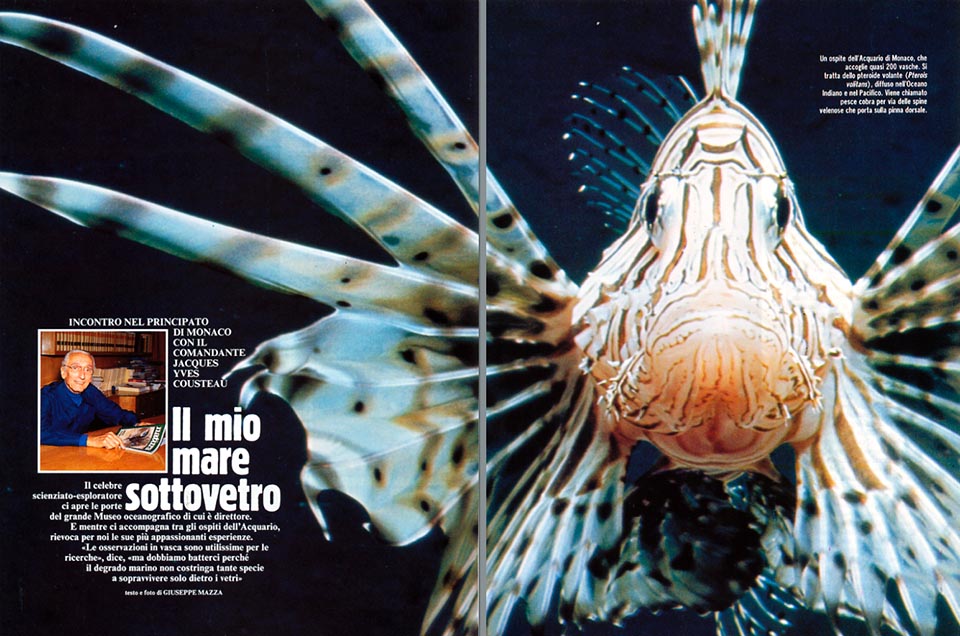
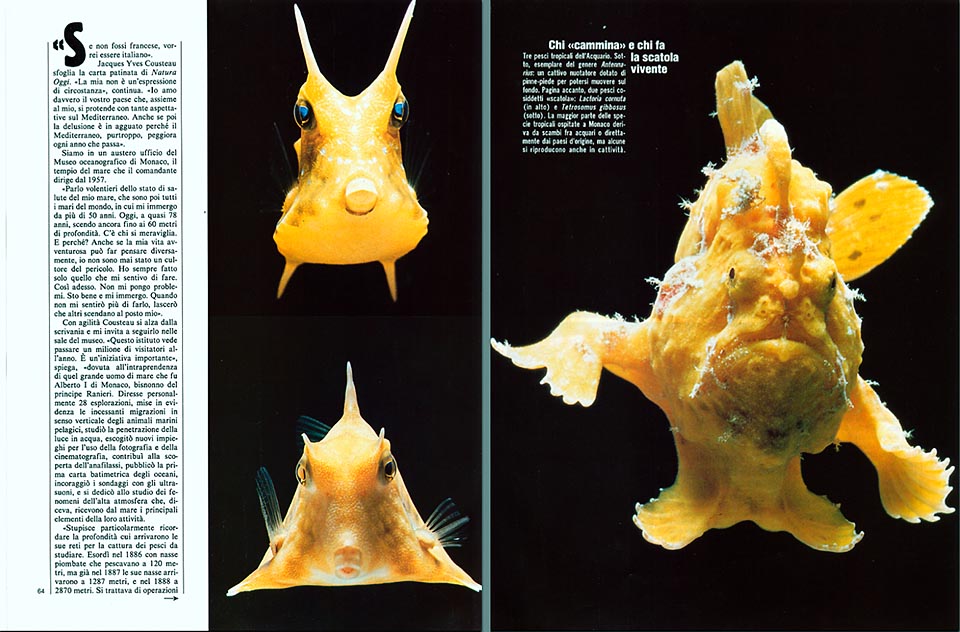
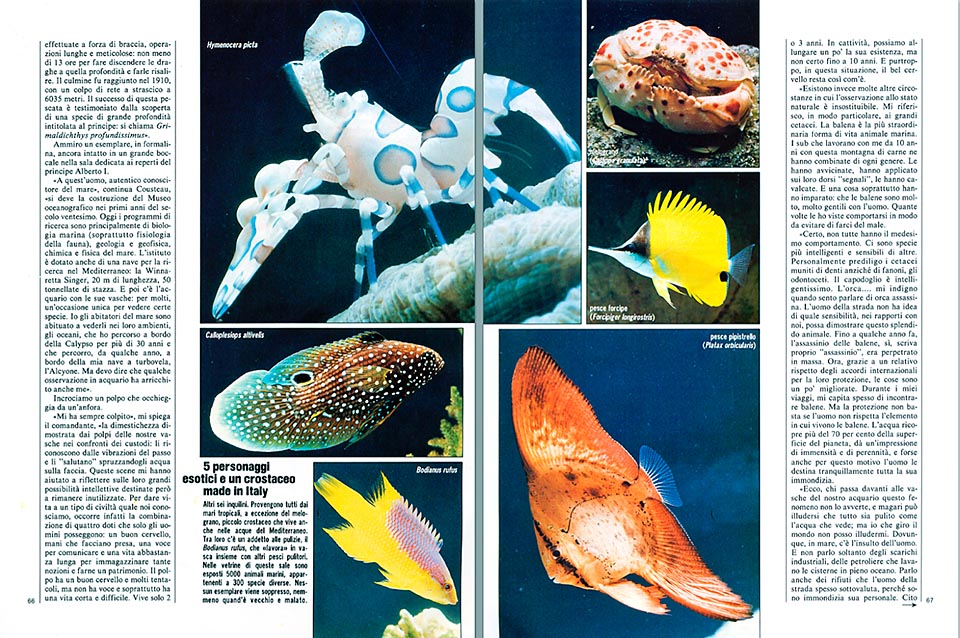
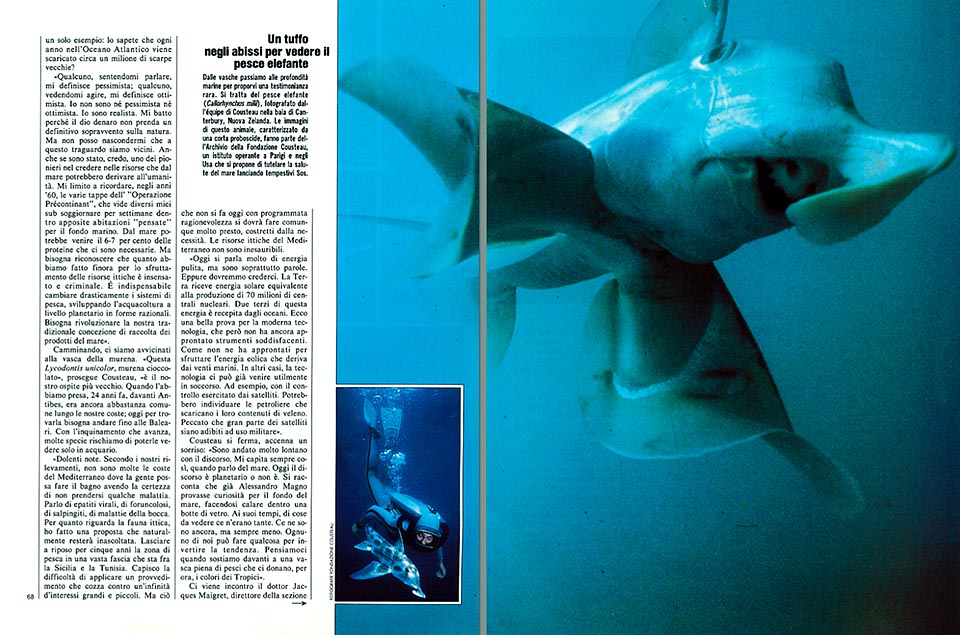
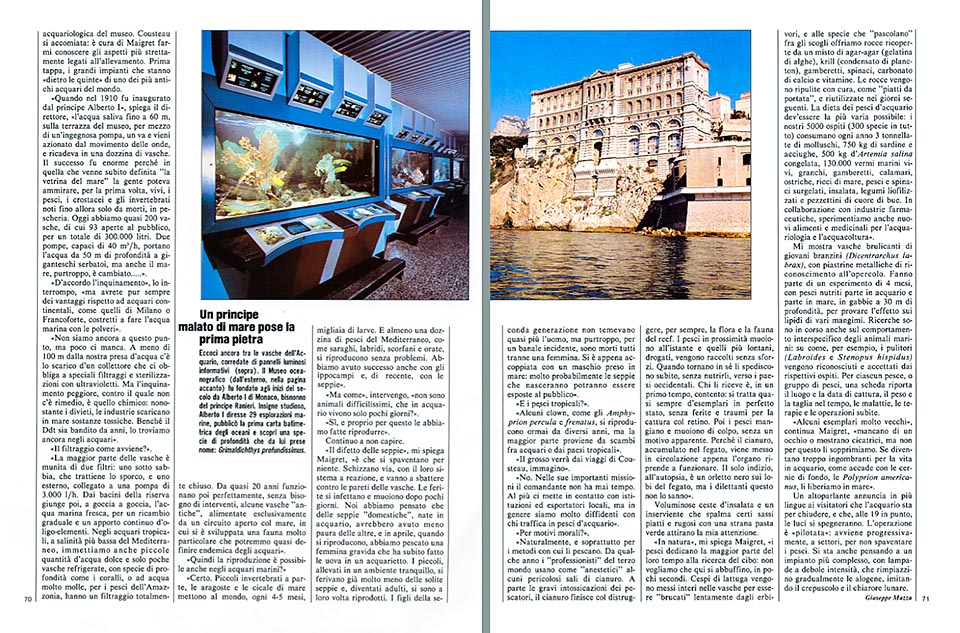

Texto © Giuseppe Mazza

English translation by Mario Beltramini
“If I were not French, I would have liked to be Italian.” Capt. Jacques Cousteau browses with some envy the glossy pages of Natura Oggi.
“My saying is not due to the circumstances”, he goes on, ” I really love your country, which, together with mine, spreads out, with many expectations, on the Mediterranean Sea. Even if, later, the deception is on stand-by, because the Mediterranean, unluckily, gets worse foe every year which is passing.”
We are in a very simple office of the Oceanographic Museum of Monaco, the temple of the sea, which is directed, from 1957, by the “Commander”.
“I talk willingly of the health conditions of my sea, which, after all, are the same for all the seas of the world, where I dive since more than 50 years. Nowadays, nearly 78, I still go down till 60 metres of depth. Some are astonished. And why? Even if my adventurous life can push to think differently, I have never been fond of danger. I have always done only what I was feeling to do. Just as now. I do not have problems. I feel good and I dive. When I will not feel any more to do it, I will leave that others go down there at my place.
Welcome, therefore, in the Oceanographic Museum of Monaco, which sees every year the presence of a million of visitors. It’s an important initiative due to the boldness of that great navigator who was Albert I of Monaco, great-grand-father of Prince Rainier.
The cure of the nation did not prevent him to realize an impressive number of missions. Persuaded, and rightly convinced, of the existence of few fields of scientific research, where the human culture can go ahead as the kingdom of the sea. He personally directed 28 explorations, with great profit for the acquisition of new knowledges. He made evident the endless migration in vertical direction of the pelagic marine animals; did study the penetration of the light in water; excogitated new utilizations for the use of photography and cinematography; had part in the discovery of anaphylaxis; proposed the employment of seaplane for fishing, but, in the meantime, denounced the devastations caused by the trailing nets; published the first bathymetric chart of the ocean; promoted soundings with ultrasound; and dedicated himself with equal passion to the study of phenomena of the upper atmosphere, which, as he was saying, “receive from the sea the main elements of their activity”.
It’s particularly astounding to remember the depth reached by his nets to catch fishes to be studied. He began in 1886 with pots, ballasted with lead, which were reaching 122 metres, but already in 1887, his pots reached 1287 metres, and in 1888, the 2870 metres. They were operations effected by dint of arms, long and meticulous operations: not less than 13 hours to lower down the drags to that depth and heave them up. The top was reached in 1910, with a blow of trailing net at 6035 metres of depth. A record which was bettered only in 1947. The success of this catch is made emblematic by the discovery of a great depth species, named after the Prince: the Grimaldichthys profondissimus“.
I admire it, plunged in formalin, still intact, in a big mug, in the room dedicated to the findings of Prince Albert I.
“To this man, genuine connoisseur of the sea,” Cousteau goes on, “we owe the construction, during the first years of the Twentieth century, of the Oceanographic Museum. Created to allow the conservation, observation, and, when necessary, the experimentation, of the creatures of the sea, it’s today endowed of laboratories and of specialized libraries. The programmes of research concern mainly marine biology (especially the physiology of fauna), geology and geophysics, chemistry and physics of the sea. The Institute is endowed also of a vessel designated for the research in the Mediterranean: it’s the Winnaretta singer, 20 metres long, 50 tons. And then, of course, there is the aquarium with its pools: for many, a unique occasion to see, with their own eyes, some species. I am used, as you well know, to see the inhabitants of the sea in their habitats, the oceans, which I have covered on board the Calypso, for more than 30 years, and which I run through, from a few years till now, on board my new turbo-sail vessel, the Alcyone. But, I must say, some observations made in the aquarium, have enriched me too.”
We come across an octopus which peers out from an amphora.
“It has always stricken me,” he explains, “the familiarity shown by the octopuses of our pools towards their guardians: they recognize them from the vibrations done by their steps and “greet” them by spraying water on their faces. Views like these have helped me to think about the huge intellective possibilities of these animals, even if it’s question of potentialities doomed to remain not utilized.
To give life to a model of civilization as we know it, in fact, the combination of four dowries is required, and this only men have: a good brain, prehensile hands, a voice for communicating with own fellows and a life sufficiently long to store many knowledges and transform them in a patrimony. The octopus has a good brain and many tentacles, but has no voice, and, above all, has a short and difficult life. It lives 2 or 3 years only. When captive, we can extend its existence just a little, but surely, we cannot reach the 10 years. And, unluckily, in such a situation, the nice brain remains as it is.
On the contrary,, many other occasions exist when the observation in the natural status cannot be replaced: much more liberty of movements, and other enthusiasms. I refer, particularly, to the observation of the big cetaceans. The whale is the most extraordinary form of animal life of the seas. The divers who work with me since 10 years, have committed every kind of folly with this mountain of flesh, they have approached them, they have applied “signals” on their backs, they have ridden them. And, above all, they have learned one thing: the whales are very, very kind with man. Many times, I have seen them behaving in such a way not to hurt us.
By sure, not all of them have the same behaviour. There are species which are more intelligent and sensible than others. Personally, I prefer the cetaceans provided with teeth instead of baleen, the toothed whales. The sperm whale is very intelligent.
The grampus … I get angry, when I hear people referring to it as killer whale. The common man has no idea of what sort of sensibility, in the relations with us, this splendid animal can display. Till a few years ago, the murder of whales, yes, write just “murder”, was massively committed. Nowadays, thanks to a certain respect of the international agreements for their protection, the situation has slightly improved. During my voyages, it happens often to me to see whales. But the protection is not sufficient, if man does not respect the element where the whale lives. The water covers more than 70% of the surface of the planet, it gives an idea of immensity and perpetuity, and, maybe, it’s for this reason that man devolves her all his filth.
Here is, he who passes in front of the pools of our aquarium, does not perceive this phenomenon, and maybe can deceive himself that all is clean as the water he sees; but, travelling around the world, I cannot cultivate illusions. Wherever, at sea, the insult of man is present. And I do not talk only of industrial waste, or oil carriers which wash their tanks in open ocean. I talk also of the waste that common men undervalue, because they are their own personal garbage. I cite only an example: do you know that every year a million of old shoes is discharged into the Atlantic Ocean?
To the short-sightedness of politicians who find uncomfortable to face certain problems, to the avidity of profit of those who speculate at the habitat’s own expenses, we have to add the blindness of all others. All do consider the sea the most handy of the bins. But, later, they open wide their eyes, when they are told that, if things go on in this way, the see is doomed to die.
But those who know the things have the duty to explain them to others. Somebody, listening to my words, thinks that I am a pessimist, others, seeing me in action, think that I am an optimist. I am neither pessimist, nor optimist. I am a realist. I fight in order that the god money does not have a final upper of nature.
But I can’t ignore that we are close to this ending. Even if I have been, I guess, one of the pioneers in believing in the resources for mankind which could derive from the sea. I confine myself in remembering, in the sixties, the various stages of the “Operation Precontinant”, which saw several of my divers live for weeks inside suitable dwelling-places “imagined” for the bottom of the sea. From the sea, we could get the 6-7% of the proteins we need. But, before, we have to honestly recognize that what we have done up to now, for the exploitation of the ichthyic resources is crazy and criminal. Fishing systems must be drastically changed, developing in rational manners, aquaculture on a planetary scale. We have to change completely our conception of harvesting the products of the sea.
I am asked to spend a few words about Mediterranean. Painful notes, as I was saying at the beginning. After our surveys, the coasts where people can bathe with the assurance of not catching any disease, are not so many. I talk of viral hepatitis, carbuncle, salpingitis, mouth ailments. They are mainly affections which are caught due to pathogenic germs which enter into the body during the time one enjoys bathing.
For what ichthyic fauna is concerned, I have put forward a proposal, which, of course, will remain unheeded. To leave quiet for five years the fishing area in an ample zone between Sicily and Tunisia. I understand the difficulty to apply a measure which collides with an infinity of big and little interests. But, what is not done now with a programmed reasonableness, will have to be done very soon, compelled by necessity. Ichthyic resources of Mediterranean are not inexhaustible.
Nowadays, we talk very much of clean energy, but it’s mainly words only. Nevertheless, they will have to believe us. The Earth receives solar energy equivalent to the production of 70 million of nuclear plants. Two thirds of this energy is received by the oceans. Here is a nice challenge for modern technology, which, however, has not yet made ready adequate instruments. Just as they are not ready to exploit aeolian energy which comes from sea winds. An immense potentiality, which is waiting for achievements, whilst we get saturated of words.
In other instances, technology can already come to help us in a very useful way. For an example, with the control effected from the air by the satellites. They could be precious in detecting the tankers which nowadays discharge at sea, undisturbed, their cargoes of poison. It’s a shame that most of the satellites are employed of military purposes.
I have gone very much far away with my talk. It happens always to me, when I discuss about sea. Nowadays, the discourse is planetary, otherwise, it does not exist. They say that already Alexander the Great was proving curiosity for the bottom of the sea, having been, himself, lowered down in the water inside a barrel of glass. At his times, there were many things to be seen.
There are still several of them, but always less. And each one of us can do something to invert the tendency. Let us think to this, while we halt in front of a pool full of fishes, which give us, for the moment, the colours of Tropics.”
Dr. Jacques Maigret, Director of the aquariology section of the Oceanographic Museum, takes care of filtering problems and of the pools.
“This chocolate-brown moray (Lycodontis unicolor),” he explains me, “is our oldest guest. When we caught it, 24 years ago, in front of Antibes, it was still a rather common catch along our coasts, but nowadays, to find it, we must go till the Balearic Islands, and with the advancing of pollution, we risk to see many species only in an aquarium.”
He shows me what stays behind the scenes of one of the most ancient aquaria in the world.
“When it was inaugurated, in 1910, by Prince Albert I,” Maigret goes on, “the water was going up till 60 metres, on the terraced roof of the Museum, by means of a clever pump, a see-saw motion caused by the movements of the waves, and was falling in a dozen of pools. The success was enormous, because in that which was immediately called “the show-case of the sea”, people could admire, for the first time, alive, fishes, crustaceans and invertebrates known till then only lifeless, in the fishmonger’s shops. Nowadays, we have almost 200 pools, 93 of which, open to public, for a total of 300.000 litres. Two pumps, of the capacity of 40 cubic metres per hour, transport the water from 50 metres of depth to huge reservoirs, but also the sea, unluckily, has changed…”
“Agreed, for the pollution,” I interrupt him, “but you will have, anyway, always some advantages compared with continental aquaria, such as Milan or Frankfurt, where they are obliged to create the sea water with powders.”
“We have not yet reached this, but we are almost there. At less than 100 metres away from our water suction, there is the discharge of a drain, which compels us to special filtering and sterilizations with ultraviolet rays, but the worst pollution, against which there is no remedy, is the chemical one. In spite of prohibitions, industries discharge continuously in the sea toxic substances, and even if it is forbidden since years, we still find traces of DDT in the aquaria.”
“Hence, reproduction is possible also in marine aquaria?”
“Sure. But small invertebrates, lobsters and the slipper lobsters, give birth, every 4-5 months, thousands of larvae and at least a dozen of Mediterranean fishes, like Diplodus, wrasses, scorpaenas, and gilt-heads, breed without any problem. We have been successful also with sea-horses, and, recently, with cuttle-fishes.”
“But, how it goes”, I interrupt immediately, “aren’t they very difficult animals, which last only few days when in an aquarium?”
I stare at him, puzzled.
“The shortcoming of cuttle-fishes,” Maigret explains, “is that they get scared for nothing. They run away very fast, with their system of reaction, and they bang against the sides of the pools. Wounds get infected, and they die after a few days. We have thought that “domestic” cuttle-fishes, born in aquarium, should have been less fearful than the others, and in April, when they breed, we have fished a pregnant female, which has immediately laid the eggs in a small aquarium. Young, brought up in a calm environment, got injured already much less than usual cuttle-fishes, and, once adult, they have reproduced at their turn. The sons of the second generation, did not almost fear man any more, but, unluckily, due to a trivial occurrence, we have been able to save only a female. This one has recently paired with a male, caught at sea, and most probably the cuttle-fishes which will come to life, will be exposed to the public.”
“And tropical fishes?”
“Some clown fishes, like the Amphyprion percula and the Amphyprion frenatus, breed since several years, but the most of them come from exchanges between aquaria, or directly from tropical countries.”
“The main part comes from Cousteau’s voyages, I guess.”
“No. During his important missions, the Commander has no time. At the most, he puts us in touch with local institutions, and exporters, but usually we do not rely too much with those who deal with fishes for aquaria.”
“For moral reasons?”
“Of course, and mainly for the methods used to fish them. Since few years, the “professionals” of the third world use as “anaesthetics”, dangerous cyanide salts. Apart the serious poisonings of fishermen, the cyanide finally destroys, for ever, the flora and the fauna of the reef. Fishes close to same, die immediately, those further on, drugged, are collected without any effort. As soon as they recover, they dispatch them at once, without feeding them, to the western countries, and the receiver in a first instance is happy. It’s matter, almost always, of specimen in perfect conditions, without wounds and traumas due to the use of the small nets. Then, as soon as they eat, they die all at once, without any apparent reason.”
“But, how is that?”, I ask, very much more interested.
“Because the cyanide, accumulated in the liver, circulates with the blood as soon as the liver resumes working. The only evidence, through the autopsy, is a black small brim on the lobes of the liver, but amateurs do not know this.”
He shows me, then, all what stays behind the pools of big aquaria: sophisticated installations for every need of filtering, UV lamps and special halogen “metal halide” ones, in lieu of the classical ‘Grolux”, which give the pools that lighting mixed of intense light and zones of darkness, typical of coral reefs. Large baskets of salad, and an attendant who smears some flat and wrinkled stones with a strange green and stinking paste, draws my attention.
“In nature,” Maigret explains, “fishes dedicate most of their time to the research of food, and we don’t want that here they eat too much, in a few seconds. Entire tufts of lettuce are placed in the pools, to be browsed slowly by the herbivores, and to the species which “graze” between the reefs, we offer rocks covered of a mixture of agar-agar (gelatine of algae), krill (concentrated plankton), shrimps, spinaches, carbonate of calcium, and vitamins. They are carefully cleaned, as “courses dishes”, and utilized again on the following days. The diet of aquarium fishes must be the most possible varied: our 5.000 guests (a total of 300 species), consume every year 3 Tons of molluscs, 750 kg of sardines and anchovies, 500 kg of frozen Artemia salina, 130.000 live marine worms, crabs, shrimps, squids, oysters, sea urchins, frozen fishes and spinaches, salad, freeze-dried vegetables, and small pieces of heart of oxen.
For feeding new-born, besides the larvae of Artemia salina, we use rotifers of Brachionus and unicellular algae of the genus Chlorella. In collaboration with pharmaceutical industries, we experiment also new aliments and medicines for the aquariology and aquaculture.”
He shows me pools swarming with little young sea basses (Dicentrarchus labrax), with metallic small identification plates on the operculum. They take part to a 4-months experiment, with fishes nourished partly in the aquarium, and partly at sea, in cages, placed at 30 meters of depth, to test the effect on the lipids of various fodders. Interesting researches are carried out also on the inter species behavior of marine animals: about how, for instance, the cleaners (Labroides and Steropus hispidus), are recognized and accepted by respective hosts. For each fish, or group of fishes, a card reports the place and date of catching, the weight and size during the time, the sicknesses, treatments, and possible operations the underwent.
“Some specimen are very aged,” Maigret continues, “they are short of an eye, or exhibit scars, but we do not eliminate them for this reason. If, like groupers (Polyprion americanum), they become too encumbering for the life in aquarium, we prefer to release them at sea. I am absolutely contrary to the “fishes object”, and to the absurd mentality of some people who has come to ask for an advice for fishes which might “match” with the colour of the curtains.”
A loudspeaker informs visitors, in several languages, that the aquarium is about to close, and that, at 1900 hours sharp, the lights will switch off. Also this operation is “driven”, and takes place progressively, by sectors, in order not to frighten the fishes. They are now also thinking about a more complex plant, with weak intensity lamps, which will gradually replace the halogens, thus imitating the twilight and the moonlight.
NATURA OGGI – 1988
→ To appreciate the biodiversity within the Osteichthyes, the BONY FISH, please click here.
